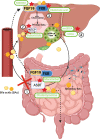Bile acids and their receptors: modulators and therapeutic targets in liver inflammation
- PMID: 35415765
- PMCID: PMC9256560
- DOI: 10.1007/s00281-022-00935-7
Bile acids and their receptors: modulators and therapeutic targets in liver inflammation
Abstract
Bile acids participate in the intestinal emulsion, digestion, and absorption of lipids and fat-soluble vitamins. When present in high concentrations, as in cholestatic liver diseases, bile acids can damage cells and cause inflammation. After the discovery of bile acids receptors about two decades ago, bile acids are considered signaling molecules. Besides regulating bile acid, xenobiotic, and nutrient metabolism, bile acids and their receptors have shown immunomodulatory properties and have been proposed as therapeutic targets for inflammatory diseases of the liver. This review focuses on bile acid-related signaling pathways that affect inflammation in the liver and provides an overview of the preclinical and clinical applications of modulators of these pathways for the treatment of cholestatic and autoimmune liver diseases.
Keywords: Bile acid receptors; Bile acids; Cholestasis; FXR; Inflammation; Liver; TGR5.
© 2022. The Author(s).
Conflict of interest statement
The authors declare no competing interests.
Figures




References
Publication types
MeSH terms
Substances
Grants and funding
LinkOut - more resources
Full Text Sources
Medical

